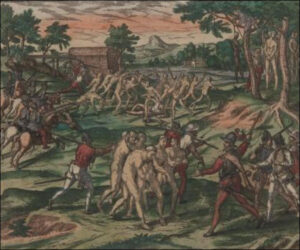After relieving Fort Magdalena from Guatiguaná’s siege, by early February 1495 (528 years ago) Columbus’s soldiers commenced a series of raids throughout the Yaque River valley to capture Guatiguaná and warriors in retribution. Guatiguaná was located and seized and, along with roughly 1,600 other Taínos, bound in rope and hauled to Magdalena and then Isabela. The 1,600 included women, children, and other non-combatants.
As depicted in Columbus and Caonabó, Columbus would select 550 of the captives to be shipped to Spain for slavery, constituting history’s first recorded large slave shipment of Native Americans to Europe. He also would award most of the rest as slaves to his men in “Española.” A year earlier, he had shipped home over two dozen Caribes and Taínos seized on Guadeloupe and St. Croix during the outward portion of the second voyage (for their fate, see blog of March 25, 2022 at fate-of-first-indigenous-captives-sent-to-spain).
The following engraving (contained in Columbus and Caonabó) depicts slave raiding, taken from Theodor de Bry (1595), courtesy of the John Carter Brown Library, portion of rec. no. 34724-5.

